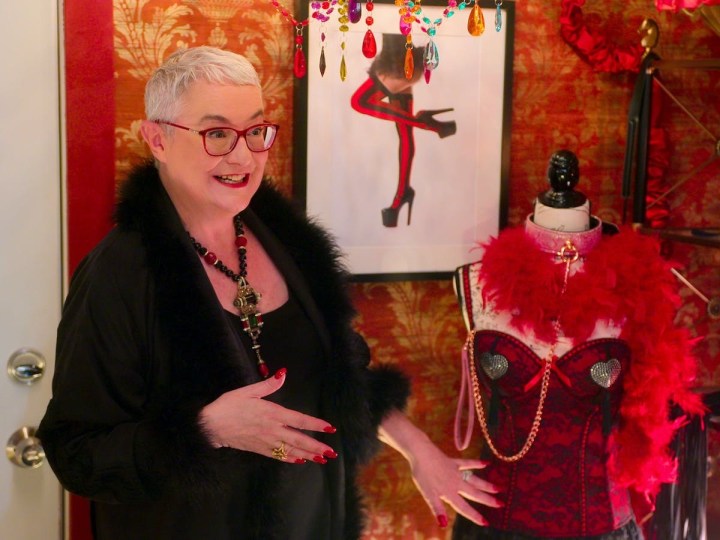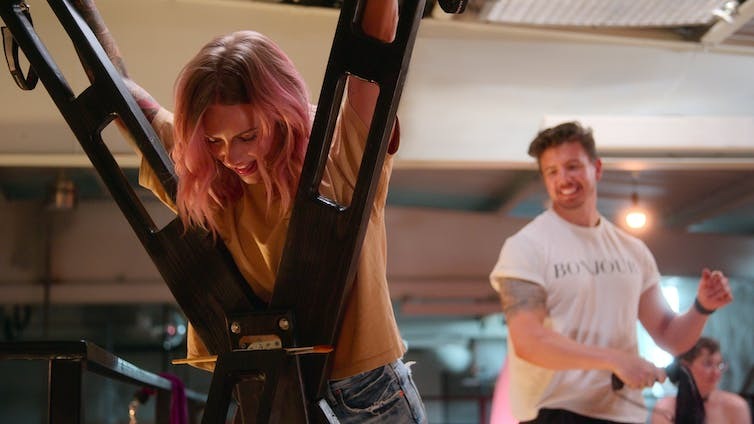THE CONVERSATION
Like Grand Designs but naughty: Netflix’s How To Build A Sex Room brings kink and sex positivity into the mainstream

'How To Build A Sex Room' is a classic home renovation reality show, with a sexy, and wholesome, twist.
How to Build a Sex Room on Netflix follows interior designer Melanie Rose as she uncovers her clients’ sex lives and designs personalised sex rooms based on their desires and needs.
The show focuses on regular people from the suburbs looking to explore their sex lives and the clients include single people, queer and straight couples, and a polyamorous family of seven. It combines the popular reality television genre of home improvement with an exploration of kink culture and a splash of sex education. Think The Block meets Secretary.
In each episode, host Melanie Rose will meet a couple, find out about their sex-lives, introduce them to various aspects of kink and sex education depending on their needs, and then design them a sex room. This ranges from couples already experienced in kink culture who are looking to broaden and deepen their experimentation, to couples who need to revitalise their sex lives or reconnect physically, and are looking for a space to do so. While there is frank discussion and even demonstration of tools and techniques, the show remains relatively inoffensive in terms of what they depict on the screen.
While the show has been praised for bringing kink practices into mainstream TV, kink has a long history across cultures. Historical interpretations vary, but elements of kink can be identified in the worshipping of the goddess Inanna all the way back in ancient Mesopotamia.
Kink is connected to and different from BDSM (bondage/discipline, dominance/submission and/or sadism/masochism). Many will be familiar with the writings of the Marquis de Sade in the 18th century, who inspired the coining of the word sadism. Modern kink and BDSM have origins in LGBTQ+ communities including 1960s-1970s leather cultures. Leather cultures were a way in which queer people could push back against social norms and build safe, underground communities to explore sexuality.
In general terms, kink refers to sexual practices that are different from current sociocultural norms. This may involve consensual negotiations of power that characterise BDSM and other activities, such as threesomes, orgies, fetish play and Shibari rope play.

In ‘How To Build A Sex Room’, couples are introduced to various levels of kink and bondage, so Melanie Rose can design a sex room that meets their needs and desires. Image: The Conversation / Netflix
Kink in pop culture
Kink, BDSM and sex positivity have infiltrated mainstream pop and social media cultures. Films such as 9½ Weeks (1986) and Basic Instinct (1992) feature bondage, impact play, and dominance and submission dynamics, while television series such as Sex and the City and Bonding have dealt with the complexity of sex, kink and relationships.
Kinksters and BDSM practitioners can connect on social media platforms like Fetlife (the Fetish version of Facebook), and there are plenty of sex-specific meet-up apps such as Feeld among others.
The book and later film series 50 Shades of Grey featuring sado-masochism were global top-sellers. Pop music icons like Rihanna and Justin Timberlake have had best-selling hits featuring lyrics about kink. BDSM gear like leather harnesses are now high fashion, and sex toys such as floggers and paddles have their own section at most online and bricks and mortar sex shops.
Destigmatising sex and desire
The incorporation of kink and sex positivity into shows like How to Build a Sex Room is important for destigmatising diverse sexual practices and desires. It reminds us that sex does not have to be about reproduction and heterosexual marriage. It can and does occur in a variety of romantic and sexual relationships, including queer and polyamorous relationships.
The show tells important stories about sex as forms of play, fun, exploration and intimate connection. It is not surprising that the series has attracted significant social media attention and positive responses from viewers, particularly for its diverse cast across age, gender, race, and sexuality.

A couple on ‘How To Build A Sex Room’ experimenting with light flogging. Image: The Conversation / Netflix
Reality TV gets an erotic makeover
However, this diversity does not extend to economic circumstances: all clients in How to Build a Sex Room appear to be working professionals and homeowners. One episode features a camper van renovation for a same-sex couple, but most episodes involve renovating a room in a spacious suburban home, raising questions about who can afford to create a dedicated sex space.
The show sidesteps questions of class and home ownership. Instead, it implies that all you need to spice up your sex life is a luxurious, custom-built play space complete with expensive soft furnishings, an array of (often expensive) sex toys, a tantric chair or sex swing, and a St Andrews cross.
I’m watching “How to Build a Sex Room” and after 2 minutes I think the answer is “Have Lots of Money”
— shawna💋 (@truelips78) July 10, 2022
At play here (pun intended) is a consumerist model of relationship transformation that relies on access to financial resources and social capital. As a spin on the home renovation-makeover genre, the show stages a rapid intervention designed to improve people’s sex lives, and enhance their intimate relationships, but these interventions are carefully staged and limited in scope.
Vanilla kink
While How to Build a Sex Room has been credited with demystifying kink and normalising diverse sexual desires, the show produces kink through a specific lens that does not reflect the wider range of kink practices, desires and settings. The mainstreaming of kink runs the risk of normalising some kink practices while re-stigmatising or simply overlooking others.
For example, the show’s emphasis on creating private play-spaces overlooks the importance of kink community and public play. Many kink communities run public play events to share important skills and educate on safe kink practices. Private play-spaces also confine intimacy to affluent, private homes.
Despite featuring diverse sexual practices, How to Build a Sex Room paints a fairly vanilla picture of sex as a private act between people in long-term relationships, living in wealthy homes with a glamorous space decked out exclusively for sex – a far cry from the everyday realities of sex.
Nevertheless, shows like this are good ways to introduce mainstream audiences to the world of kink. A world that can be exciting, pleasurable and sexy. DM/ML
This story was first published in The Conversation.
Andrea Waling is an ARC DECRA Senior Research Fellow in Sex & Sexuality at La Trobe University. Jacinthe Flore is a Postdoctoral Research Fellow at RMIT University. Kiran Pienaar is a Senior Lecturer in Sociology at Deakin University.
Visit Daily Maverick’s home page for more news, analysis and investigations



















Comments - Please login in order to comment.